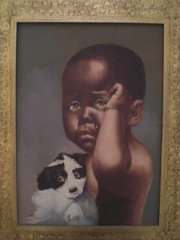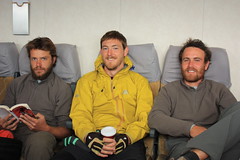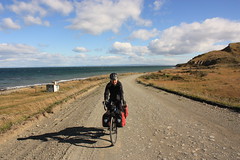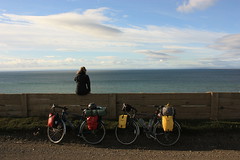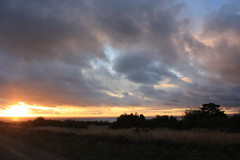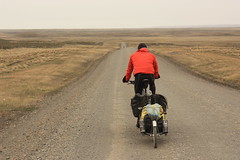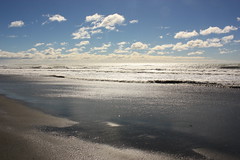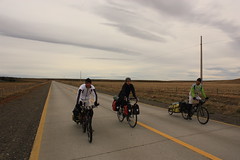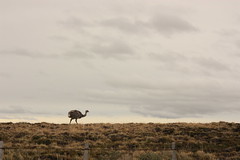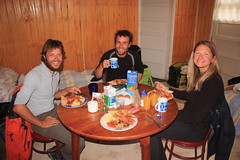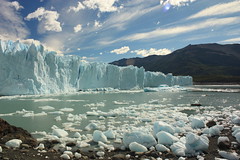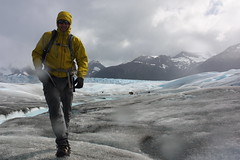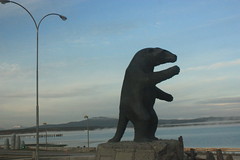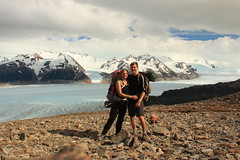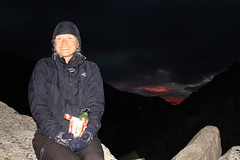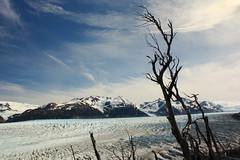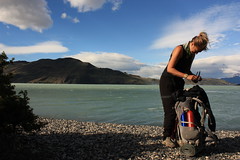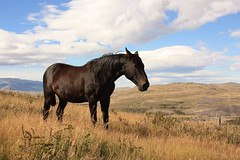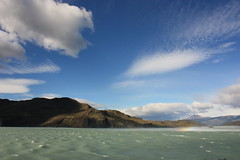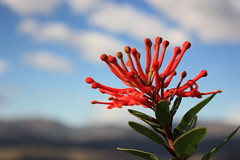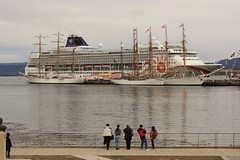
We were sad to be starting the last leg of the trip but we were glad to be leaving the flat windswept plains of northern Tierra Del Fuego for the mountains that curl eastwards along the north shore of the Beagle Channel. We followed the Atlantic coast for a while and, looking out to sea, it was amazing to think that we are now so far south, there is no land to either the east or the west ... just open ocean. The ride south of Rio Grande to Tolhuin was easy enough and we were faster than expected because the wind had dropped significantly. We had a few stretches where the road turned westwards, straight into the wind, and if the gusts from the previous few days had continued, we would have crawled along at about 6-7km/hr. As it was we maintained a fairly consitent speed of about 30km/hr and completed the 120km in just under 5 hours. We were also spurred on by the occasional glimpse of the snow covered peaks that surround Lago Fagnaño. It's been one of the amazing aspects of this trip, when the landscape surrounding you is built from such huge natural features; deserts, vast salt flats, huge mountains, and the oceans, you can often see your destination from quite early in the day. Despite the distance being over 100km, we could see the ghosts of the mountains from just 20-30 km out of Rio Grande, and they just got bigger and closer with every hill climbed.
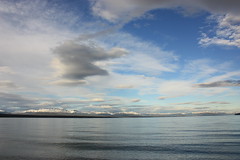
We camped in Tolhuin by the vast, picturesque, and extremely cold Lago Fagnano. It has an amazing setting, lying to the north of, and paralell to, the mountains that plunge into the Beagle Channel. It is a huge body of clear glacial water fringed with pebble beaches and smooth driftwood. The colours here are somehow always cold; even when the sun set, the usual oranges and reds seemed to lack any warmth. We had been cycling all day with full thermals, gloves, coats and hats and we didn't take much of it off to sleep in the tent that night. Luckily, there was a log cabin where we could light a fire and keep warm before the dash to the sleeping bags. We met another French bike tourer here who was just starting out on his trip and had just completed his first day. Olivier was a really nice guy but we all felt sick with jealousy as he had the whole adventure ahead of him.
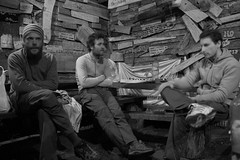
We wished Olivier the best of luck the following morning and set off south as he headed north. We had anticipated stronger winds than we seemed to be getting, and it now seemed possible to combine the next two days we had thought necessary to reach Ushuaia from Tolhuin. The last day of cycling had crept up on us and it seemed to have arrived too early. We were however glad to have one last mountain pass to complete before the end of the journey; it seemed fitting that after following the Andes for nearly 6000km, cycling over 4500 of them, we should cross them one last time to drop into our final destination, Ushuaia ... el Fin Del Mundo.
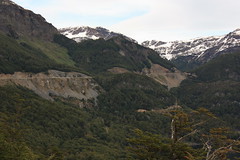
Without telling Catherine, I had secretly hoped to be cycling through snow on the Paso Garibaldi because it would look 'atmospheric' in photos, although we seemed to have arrived a month too early. We were surrounded by beautiful mountains on all sides but the snow line was still well over 100m above us. Fortunately our first view of the Beagle Channel and it's islands, suddenly appearing during an amazing descent through the mountains behind the city, more than made up for it. The southernmost limit of our journey didn't disappoint; it was packed with small sailing boats, sturdier vessels heading for Antarctica, and even a succession of tall ships making a short stop during a round the world regatta.
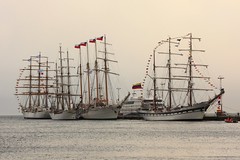
We headed for the puerto for a few photos in front of the 'Fin Del Mundo' sign, and congratulated ourselves on completing a mammoth journey from the arid deserts of the north all the way to the frozen southern tip of the continent. I'm sure the locals must be used to seeing odd foreigners in tights, high-fiving eachother by the sign, pretty frequently but plenty were still kind enough to ask us about the trip and congratulate us.
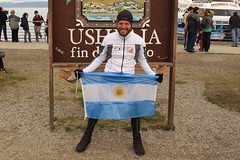
We did however have one last task for the day: Together with Pierrick and Vincent (who were celebrating their 7000km with a bottle of Beaujolais from home), we had promised ourselves that we would go to a bar and drink so much that we would forget our own names. The night was a success and we were still in a bar at 4am drinking with the Potuguese navy and some guys from the Argentine Airforce (avoiding awkward conversations about the Falklands!). If anyone was wondering, it takes 14 bottles of local 'Beagle' beer before a Portuguese naval officer will admit to being prepared to fire on a civilian Spanish vessel if nobody would find out.
Well, we made it. Whilst we let it sink in and think about how best to sum up the trip of a lifetime, here are some exciting statistics from the last four and a half months on two wheels ... and occasionally two legs:
Exciting Cycling Stats:
Total distance cycled: 4627km
Total no. of days cycled: 54
Longest distance cycled in one day: 158km
Most shameful daily distance (without a specific destination): 38km (excuse: mudslide had destroyed road)
Fastest speed: 70km/hr
Fastest speed (sober): 66km/hr
Hottest (known) daily temperature cycled: 45 degrees celcius
Longest unbroken stretch of sunny days: 31
Total days cycling in rain: 5
Highest pass cycled: 3000m (Highest altitude off the bikes: 5300m in Bolivia)
Longest continuous climb: 35km
Longest continuous descent (without pedalling): 26km
Largest (known) altitude gain in one day: 2000m
Miscellaneous stats:
No. of dogs & cats unofficially adopted by Catherine: 45,328
Most pointless town: Talocasta (1 resident)
Worst injury & most spectacular crash: Catherine's speedy 'descent' into Bardas Blancas
Best Cuisine: Any Asado (although special mention has to go to Doug in Capitan Montoya)
Worst cuisine: Bolivian 'Bangers and Mash'
Successful marriage proposals: 1
Most useful Spanish phrase learned: 'Claro'. Translation: 'Got you', 'understand', 'yep', 'sure', 'with you on that one'. This allows you to 'participate' in conversations of which you can understand nothing.
Worst stretch of road: A lot of competition here between the many corrugated, sandy stretches of ripio throughout the journey, but it has to be cycling the 8-lane motorway out of Mendoza.
Longest continuous distance cycled with a dog chasing the wheels: 30km (between La Junta and Puyuhuapi)
Most dangerous animal encountered: It's a toss up between 'all birds' (we've seen them eating every other animal on the continent), and the ants in the desert north of Chilecito because they tried to eat the bikes
Number of times a lorry driver indecently exposed himself to us: 1
(un)Official sponsor of the trip: Quilmes Cristal Cerveça
New favourite wine: Bodega Fin Del Mundo - 'Ventus' (tinto, tres varietales)
Food most likely to start a fight if offered to either of us within the next year: salami or pasta
10 English Pounds will buy you:
A 250km coach journey in Argentine Patagonia
6 beers in a Chilean brothel
4-bed cabaña in northern Argentina
One dorm bed in Southern Patagonia
8 blasts on the microwave in a Coyahique hostel (the cheek)
Enough top-quality Argentine meat to feed a starving family of 10 with an asado
A one-hour massage from a tranny in Bariloche
Boring bike stats:
Punctures: 5 (all mine) - Catherine cycled over 4500km over some unimagineably bad terrain without a single puncture. A shining advertisement for Schwalbe Marathon Plus tyres.
Broken spokes (whilst riding): 2 (mine)
Snapped chain: 1 (mine)
Broken headset: 1 (mine)
Bald tyres: 1 (mine)
Broken pannier racks: 1 (mine)
Regrets that I didn't buy Catherine's bike: 1 (mine)
I rode a 2008 Panorama Ridgeback with Blackburn lowrider aluminium racks and Continental tyres, whilst Catherine rode a (seemingly indestructible) 2008 Dawes Horizon with similar Blackburn racks and Schwalbe Marathon Plus tyres. We both ran 27inch wheels with 'road touring tyres' (and spent the holiday explaining the decision to everyone else on 26inch mountain bike fat tyres). We both had to replace cables, brake pads and the chains and cassettes, but this was part of the wear and tear we expected prior to the trip. The Ortlieb panniers were faultless, as expected due to the glowing reports on other people's cycling blogs. There were many tricks that we learned along the way and there are some aspects that we would change for a subsequent trip but overall, the bikes and equipment lasted incredibly well considering the demands.4-bed cabaña in northern Argentina
One dorm bed in Southern Patagonia
8 blasts on the microwave in a Coyahique hostel (the cheek)
Enough top-quality Argentine meat to feed a starving family of 10 with an asado
A one-hour massage from a tranny in Bariloche
Boring bike stats:
Punctures: 5 (all mine) - Catherine cycled over 4500km over some unimagineably bad terrain without a single puncture. A shining advertisement for Schwalbe Marathon Plus tyres.
Broken spokes (whilst riding): 2 (mine)
Snapped chain: 1 (mine)
Broken headset: 1 (mine)
Bald tyres: 1 (mine)
Broken pannier racks: 1 (mine)
Regrets that I didn't buy Catherine's bike: 1 (mine)
... and here is a photo of my favourite painting seen during this trip:
